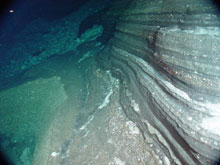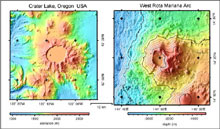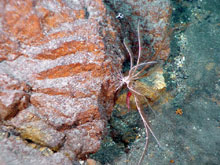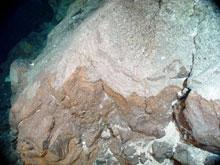
Interlayered basaltic (dark) and felsic (light) ash layers in the east wall of West Rota caldera. This cliff is approximately 3 m (9 ft) tall. Click image for larger view.
An Enormous 'Room for a Hot Bath' at West Rota Volcano
April 4, 2004
Bob Stern
Professor, Geosciences Department
University of Texas at Dallas
A few days ago we took a good first look at a dead volcano that had a tremendous eruption sometime in the recent past. The most violent volcanic eruptions are associated with two features: felsic magmas and the formation of big calderas. Felsic magmas have the highest contents of silica (SiO2) and are dangerous because the silica molecules combine to form chains that make the magmas very viscous (sticky). Felsic magmas also contain a lot of gas. The high viscosity can trap the gasses, producing pressures that result in incredibly powerful, explosive eruptions. These eruptions can also produce the frothy rocks that float, known as pumice. Most of the cataclysmic eruptions of the recent past (Santorini, Krakatoa, Pelee, Mt. St. Helens) have been the result of powerful eruptions of felsic lava. The most powerful felsic eruptions can produce a large depression, called a caldera, after the Latin word for "room for a hot bath." We are just starting to find evidence that similar eruptions occur on the sea floor.

A comparision of Crater Lake and West Rota calderas. Note the similarly sized calderas of these volcanoes (images are at the same scale). Click image for larger view and more details.
We used the ROPOS ROV (remotely operated vehicle) to study West Rota volcano, which has a caldera comparable in size to Crater Lake in Oregon. A previous expedition discovered this caldera during a mapping survey of the sea floor in 2001 and recovered some samples from it with a dredge. The dredge sample told us that this was a very interesting volcano (science team member Neil Basu, a graduate student at the University of Texas at Dallas, is studying these rocks as part of his Master’s research). The problem with dredging, however, is that you can’t tell how different rocks relate to each other: which are older or younger, whether there are faults, etc. Understanding these relationships is critical to understanding Earth processes and history. A technologically advanced ROV such as ROPOS allows us to study the rocks on the sea floor just like a geologist can study rock formations on land.

Columnar jointing in a pumice boulder on the top of West Rota volcano. Note the crinoid growing on the surface. The rock section shown is approximately 0.5 m (18 in) high. Click image for larger view.

A contact between the lower basaltic and upper felsic ash units in the wall of the West Rota caldera. The outcrop is approximately 2 m tall. Click image for larger view.
We used ROPOS to perform an "autopsy" on this intriguing dead volcano. The ROPOS dive lasted about 8 hrs. The submersible ascended from about 1,300 to 350 m (3,900 to 1,050 ft) below the sea surface. The first two-thirds of the dive was monotonous. While moving across the caldera floor, we saw little but pumice that ranged in size from tiny pebbles to boulders. We could tell that this pumice came from the steep upper slopes of the volcano. At about 750 m depth, we encountered a different rock, a basaltic lava exposed in the vertical cliffs. We were looking at the insides of the volcano, unveiled by the explosive eruption that produced the caldera. We ascended the cliff and watched as the history of the volcano was revealed, beginning with mafic lavas (with high concentrations of magnesium and iron) and then basaltic ash layers that were succeeded upwards by felsic ash deposits. These ash deposits became thicker and coarser as we ascended the cliffs until we reached the top, where the products of the final eruption were located. These huge pumice boulders were up to 3 m (9 ft) in diameter!
Although this volcano is now under water, reconstructing its slopes indicates that it might have risen up to 500 m (1,500 ft) above sea level at one time. The pumice boulders show a distinctive internal structure characterized by columnar jointing. It seems that as this volcano evolved, it produced increasingly felsic (higher silica content) magmas. It erupted with intensifying violence until the summit of the volcano collapsed in a cataclysmic eruption that produced the central caldera. How long ago did this happen? We don’t know, and won’t know for sure until we can date the rocks we collected. Submarine Ring of Fire geologists suspect that it exploded a few thousand to tens of thousands of years ago. The volcano is now quiet, and the absence of a strong hydrothermal plume in the waters above it suggests that there is not much magmatic heat stored below its surface. This could change in the future, though. Perhaps someday this volcano will again become active and resume the volcanic cycle of growth, magmatic evolution, and violent destruction.
Sign up for the Ocean Explorer E-mail Update List.



























